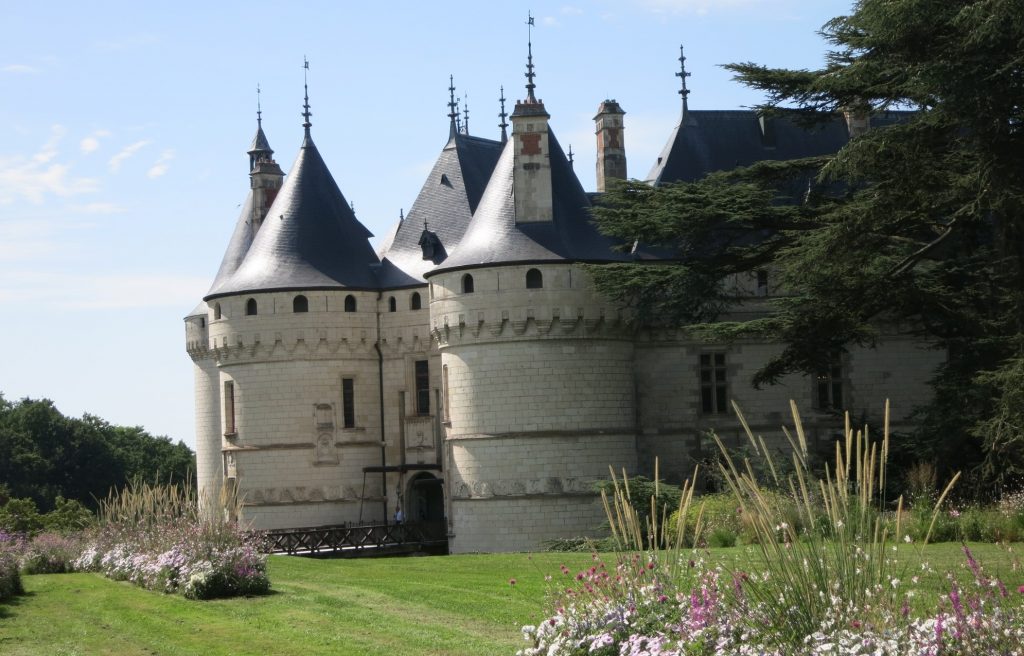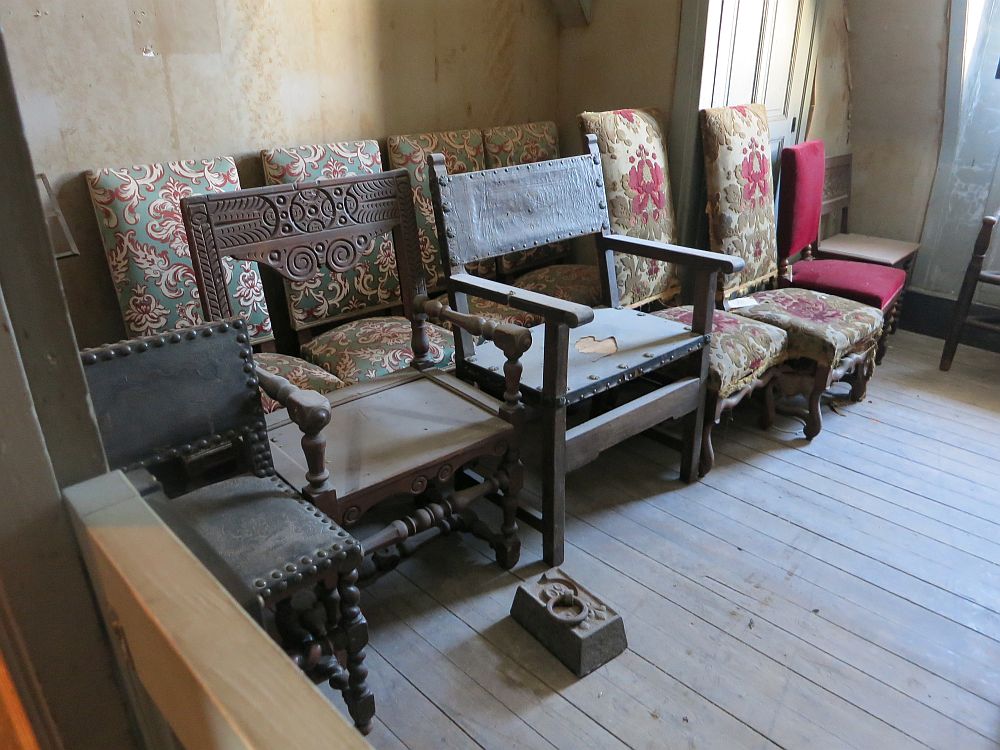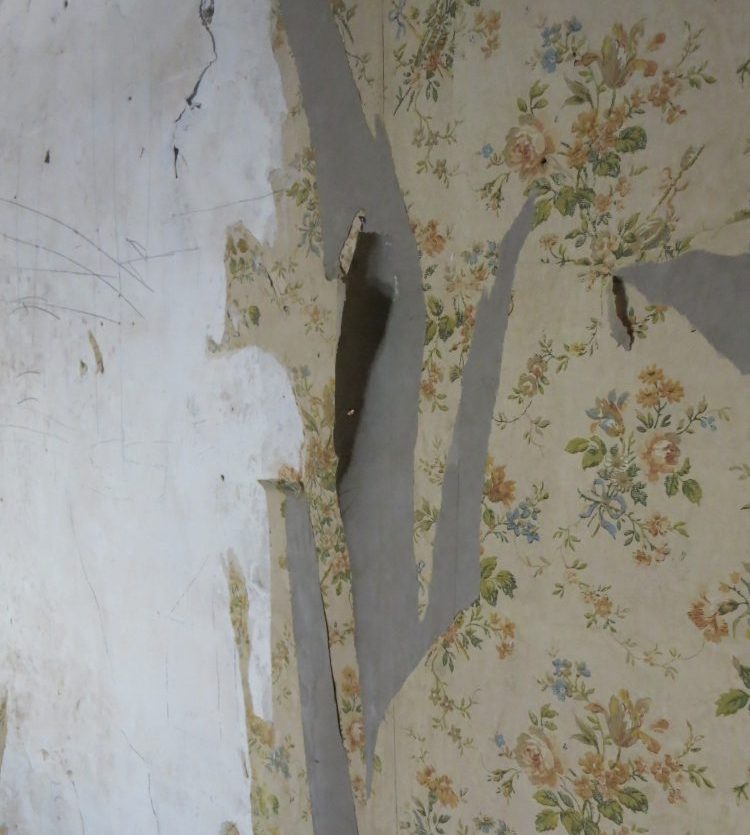Forbidden Spaces in Chateau Chaumont
What intrigues me almost as much as the chateaux we’ve visited, is what we usually haven’t seen.
The rooms that are all done up for the tourists, dressed up, you could say, are lovely: period furniture; beamed, painted ceilings; ornate tapestries; and so on. There are signs explaining who lived there, along with interesting factoids about how they lived. This is all fascinating.

But when I traveled in Europe as a young woman, what I often did in historical buildings like a chateau, or at least tried to do, was to see the rooms that weren’t on the signposted tourist route. I would hang back, trailing behind the group, until I could separate from the group entirely. I would still follow them at a distance, but would take detours whenever I had the chance: I’d peek into rooms that were blocked off, try all the closed doors, follow the winding stairway further up, that sort of thing.
And sometimes I’d succeed: a door would be unlocked, or, turning a corner, I’d find a room wide open. I never actually walked into these forbidden rooms; I would just look at them from the doorway. Usually they were works in progress: they’d have the bare bones of the historical room, like a huge fireplace or painted ceiling. But they’d be littered with work equipment: ladders and other tools, with sheets covering furniture and statues. There would often be anachronistic touches, like a boom box sitting in the middle of all the equipment scattered about.

I thought about this yesterday, when we visited Chateau Chaumont, one of the famous chateaux on the Loire. It had the usual self-guiding route, signposted with arrows leading to each prescribed step of the tour. But it had additional rooms open temporarily for an art exposition by Sarkis.
Sarkis had installed a single stained-glass window in front of the existing window in each of many rooms on the top floor of the chateau. I didn’t really look at the artwork much because I found this chance to see unfinished rooms far more interesting.
Judging by the state of repair of these rooms, this part of the chateau is not normally open to visitors. The rooms were all either empty or being used as storage, and fit the look of a much later century than the public rooms of the chateau.
It must have been servants’ quarters, judging by the size of the rooms. The walls were not the original ones; the rooms in the chateau’s earlier incarnations must have been considerably larger. I could see this when I noticed that one of the narrow hallways had one of those huge stone fireplaces characteristic of medieval and renaissance halls. The wall just a meter from it must have been added later.
Most of the rooms were completely empty and bare, with plain earthenware tile or creaky, unfinished wood for flooring. Many had a plain marble-looking fireplace, but that was all.

Some of the smaller rooms were being used for storage: light fixtures, furniture, medieval armor, china. We couldn’t go into the rooms, but each was closed with only the bottom half of a door, so we could have a good look around. All of that stuff stored there made me wonder how much more antique bric-a-brac there must be in all of these hundreds of chateaux scattered throughout this part of France.

And although this was sanctioned snooping, I felt the same thrill as back then, sneaking off the tour: seeing the forbidden spaces. It’s like viewing wild animals on safari instead of in a zoo: I was seeing the chateau’s natural environment, in a way. Its natural environment is less photogenic, less aesthetically pleasing, but feels like it’s more real.
Update: added October 2024
I wrote this back in 2013 – one of my oldest blog posts. I haven’t changed the above at all, but I think it’s worth adding some information here.
Besides visiting the historical castle, you can visit the Centre for Arts and Nature on the Chaumont estate. A permanent collection is situated outdoors around the grounds outside, in the stables, and inside the castle itself. Some of the Sarkis stained-glass artworks, designed for that exhibit I saw back in 2013, are still there in the top-floor servants’ quarters.
Each year there are temporary exhibitions as well. Check their website to see what’s planned. If you’re into art and want to tour the historical chateau as well, you should probably plan to spend most of a day there.
Chateau Chaumont: Between the towns of Blois and Amboise. It’ll take about two hours to drive from Paris. If you’re traveling by train, get off at the Onzain-Chaumont-sur-Loire station. The chateau is about 2.5 km (1.5 mi) from there, so you can walk it or take a taxi. Opening hours vary depending on time of year, but usually it opens at 10:00. Admission €20. Website.
My travel recommendations
Planning travel
- Skyscanner is where I always start my flight searches.
- Booking.com is the company I use most for finding accommodations. If you prefer, Expedia offers more or less the same.
- Discover Cars offers an easy way to compare prices from all of the major car-rental companies in one place.
- Use Viator or GetYourGuide to find walking tours, day tours, airport pickups, city cards, tickets and whatever else you need at your destination.
- Bookmundi is great when you’re looking for a longer tour of a few days to a few weeks, private or with a group, pretty much anywhere in the world. Lots of different tour companies list their tours here, so you can comparison shop.
- GetTransfer is the place to book your airport-to-hotel transfers (and vice-versa). It’s so reassuring to have this all set up and paid for ahead of time, rather than having to make decisions after a long, tiring flight!
- Buy a GoCity Pass when you’re planning to do a lot of sightseeing on a city trip. It can save you a lot on admissions to museums and other attractions in big cities like New York and Amsterdam.
Other travel-related items
- It’s really awkward to have to rely on WIFI when you travel overseas. I’ve tried several e-sim cards, and GigSky’s e-sim was the one that was easiest to activate and use. You buy it through their app and activate it when you need it. Use the code RACHEL10 to get a 10% discount!
- Another option I just recently tried for the first time is a portable wifi modem by WifiCandy. It supports up to 8 devices and you just carry it along in your pocket or bag! If you’re traveling with a family or group, it might end up cheaper to use than an e-sim. Use the code RACHELSRUMINATIONS for a 10% discount.
- I’m a fan of SCOTTeVEST’s jackets and vests because when I wear one, I don’t have to carry a handbag. I feel like all my stuff is safer when I travel because it’s in inside pockets close to my body.
- I use ExpressVPN on my phone and laptop when I travel. It keeps me safe from hackers when I use public or hotel wifi.




I think I know what you mean. A roped off room, a closed door – there’s a magnetic pull, a bit like a do not enter-sign. I like the peeling wallpaper photo. Wondering if one of the former residents (kids, perhaps) started the peeling to see what was behind. Or just to rebel.
Well-said. I was picturing that flowered wallpaper as being the background to some pretty unhappy chambermaids and other servants having to keep that whole place clean.
A great idea Rachel. Loved the behind the scenes shots. When we were in Croatia this year we went to the smallest town in the world, Hum. While I was walking around the town (which was deserted apart from myself and my husband) I found a church and wondered if it was open. I subsequently tried all the doors – even around the side. They were locked. When I returned to the Cafe with a view and went inside I saw a full bank of surveillance screens behind the cash register. Someone would have been watching my every move lol.
Yes, I suppose that’s a risk these days! But trying the doors isn’t illegal, is it?
Even though there’s a bit of allowed snooping, it’s always interesting to see what is behind the tourist attractions and wondering what the rooms might have looked like years ago. I was just as intrigued by the armor as you were, wondering if they are hidden in other chateauxs!
I suppose that’s why some places give ‘behind the scenes’ tours: people want to see what’s behind the image.
Rachel, I find places like this interesting. I guess it is a trait of curious people. Once in Munich, one of my friends needed to use the restroom. After walking around, we found this restaurant but nobody was around. We saw signs for the restroom pointing towards the second floor. We went up and ended up in more sumptuous dining room you can imagine. I was beautiful! We used he restroom and left. But, we didn’t see anybody while at the restaurant.
It’s the whole off-the-beaten-track thing. We want a different experience than ‘the masses’.
Isn’t that a bit naughty of you?Nice photos! thanks for the link up! 🙂
What can I say? I was young and reckless… though I can’t say I wouldn’t do it again! But this time it was allowed because of the art exhibit being held in those attic rooms.
:))
Hi Rachel. Great post! There is always something to be said for taking a taste of the forbidden (or at least off the beaten path) fruit! Your shots definitely feed the imagination. #TPThursday
Thanks, Nancie!
Pretty gutsy, Rachel but I agree: this is where the true story of the place lies – beyond the areas where they want you to see. I’ve always been intrigued to find out what’s being kept from view but I’m usually too much of a chicken (what if the floor gives way, or something falls on me) to actually follow the forbidden road.
I won’t claim any bravery; that’s why I generally just looked into the back rooms and didn’t enter them!